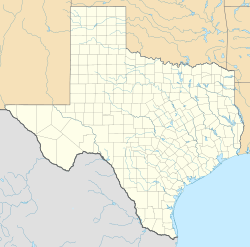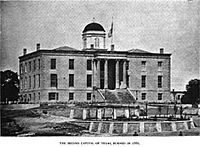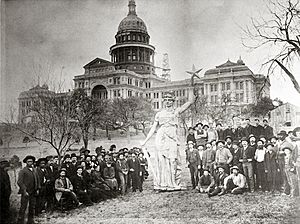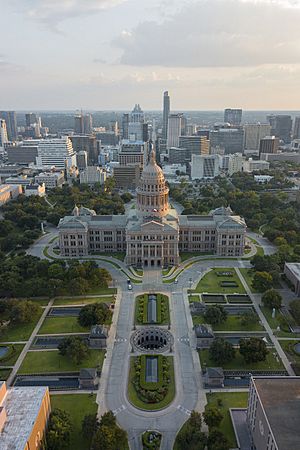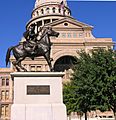Texas State Capitol facts for kids
|
Texas State Capitol
|
|
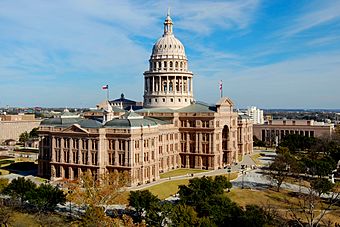
At the time of its construction, the capitol was billed as "The Seventh Largest Building in the World".
|
|
| Location | Congress Avenue and 11th Street Austin, Texas, U.S. |
|---|---|
| Area | 51.4 acres (20.8 ha) |
| Built | 1885 |
| Architect | Elijah E. Myers |
| Architectural style | Italian Renaissance Revival |
| NRHP reference No. | 70000770 |
Quick facts for kids Significant dates |
|
| Added to NRHP | June 22, 1970 |
| Designated NHL | June 23, 1986 |
The Texas State Capitol is where the government of Texas works. It's located in Austin, Texas, and it's where the Texas Legislature (the lawmakers) and the Governor of Texas have their offices.
The building was designed by Elijah E. Myers in 1881. Construction started in 1882 and finished in 1888. Later, in 1993, a large underground part was added. This important building was recognized as a National Historic Landmark in 1986.
The Texas State Capitol is about 303 feet (92 meters) tall. This makes it one of the tallest state capitol buildings in the United States. It's even taller than the United States Capitol in Washington, D.C..
History of the Texas Capitol Building
The building you see today is actually the fourth capitol building in Austin. The first one was a small wooden building. The second was made of limestone and built in 1853. It stood on the same spot as the current capitol.
Sadly, the second capitol building burned down in 1881. But don't worry, plans were already being made for a much bigger and better building! While the new capitol was being built, a temporary one was used nearby. That temporary building also burned down later in 1899.
Building the Capitol: A Grand Project
The current capitol was designed in the Italian Renaissance Revival style. This means it looks like grand buildings from the Italian Renaissance period. The money to build it came from selling public lands.
In a huge trade, the builders of the capitol were paid with over three million acres of land in the Texas Panhandle. This land later became the XIT Ranch, one of the biggest cattle ranches in the world! The total cost for the original building was about $3.7 million. Many workers, sometimes as many as a thousand, helped build it.
The building has been updated several times. For example, air conditioning was added in 1955. The most recent big updates were finished in 1997.
Choosing the Right Stone
The original plan was to cover the building with limestone from a place called Oatmanville. But this limestone had a lot of iron, which made it turn rusty when exposed to weather.
Luckily, some business partners who owned Granite Mountain offered to donate beautiful pink granite for free! This "sunset red" granite was perfect. A special railroad track was built to bring the heavy stone from Marble Falls to Austin. Sometimes, trains would derail on a sharp bend, spilling some granite. These fallen rocks are still there and are a cool local sight!
Many state buildings in Austin now use this same pink granite. About 86 granite cutters from Scotland were part of the 900 workers on the project.
Laying the Cornerstone and Grand Opening
The first stone of the capitol was laid on March 2, 1885. This day is important because it's Texas Independence Day. The building officially opened to the public on April 21, 1888, which is San Jacinto Day.
The dedication ceremony was a huge week-long party! Nearly 20,000 people came to celebrate from May 14-19, 1888. There were military shows, cattle roping, baseball games, singing, and fireworks. People could even buy souvenirs like pieces of the red granite!
Protecting the Capitol's View
In 1931, Austin passed a rule to limit how tall new buildings could be. This was to make sure the capitol building would always stand out and be easily seen. For many years, only the University of Texas Main Building Tower was taller than this limit.
But in the 1960s, developers planned a tall new building called the Westgate Tower near the capitol. Many people, including the governor, were worried it would block the view. Even though the Westgate Tower was built, the debate continued.
Later, even taller buildings were planned downtown. So, in 1983, a law was passed to create "Capitol View Corridors." These are special pathways where no construction is allowed to block the view of the capitol from certain spots around Austin. This law helps keep the capitol visible and grand from many parts of the city.
Capitol Expansion and Renovations
In 1983, a fire started in the capitol building. It caused a lot of damage to one part of the building. After the fire, the state decided to fix and update the building's systems.
In 1985, the original Goddess of Liberty statue was taken off the dome by helicopter. A new statue, made of aluminum, was put in its place in 1986. The old statue was restored and is now displayed at the Bullock Texas State History Museum.
The state also needed more space for offices. Instead of building a new office building above ground, they decided to build under the north plaza. In 1993, a huge underground extension was finished. This four-story addition doubled the space available! Even though it's so big, you can barely see it from above ground, except for some skylights that look like garden rows.
In 1995, the original building was fully restored. Then, in 1997, the park-like grounds around the capitol were also renovated.
More recently, in 2016, a big renovation project called the Texas Capitol Complex began. This project aims to create a "Texas Mall" by expanding the open space around the capitol. Part of this plan made Congress Avenue a pedestrian-only area near the capitol, with beautiful tree-lined paths. This helps bring state offices closer together and makes the area even nicer for visitors.
Design and Features of the Capitol
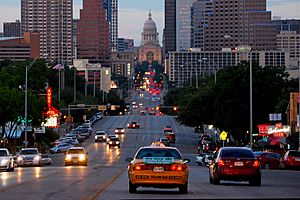
The Texas State Capitol sits on a hill overlooking downtown Austin. Its main entrance faces south towards Congress Avenue Historic District, creating a beautiful view. The University of Texas at Austin is just a few blocks north.
The Capitol Building Itself
The capitol is a large, rectangular building with a central four-story part and three-story wings on each side. A tall dome rises from the center. It's built in the Italian Renaissance Revival style and looks a lot like the United States Capitol. However, its outside is covered with local red granite.
The building has about 360,000 square feet of space, not counting the underground extension. It covers about 2.25 acres of land. Inside, there are nearly 400 rooms and over 900 windows!
The middle of the building has an open rotunda under the dome. Huge cast-iron staircases go up from the rotunda to different levels. The two main groups of the Texas Legislature—the Texas Senate and the Texas House of Representatives—meet in large rooms on the second floor. Visitors can watch from public galleries on the third floor. The rest of the building holds offices, courts, and important records. More offices are in the underground extension.
Art and History Inside
In the central rotunda, you'll see portraits of all the past presidents of the Republic of Texas and governors of the State of Texas. The rotunda is also a "whispering gallery," meaning if you whisper on one side, someone on the other side can hear you clearly!
In the south entrance area, there's a big portrait of David Crockett. You can also see a painting showing the surrender of General Santa Anna after the Battle of San Jacinto. There are also sculptures of famous Texans like Sam Houston and Stephen F. Austin, made by Elisabet Ney.
The Capitol Grounds and Monuments
The Capitol building is surrounded by 22 acres of beautiful grounds. These grounds have many statues and monuments. In 1888, a civil engineer named William Munro Johnson helped design the layout of the grounds.
One of the first monuments, honoring the Heroes of the Alamo, was put in place in 1891. There's also a "Great Walk" made of black and white pavement, shaded by trees. Other old monuments include the Volunteer Firemen Monument (1896), the Confederate Soldiers Monument (1903), and the Terry's Texas Rangers Monument (1907). These monuments are placed along the Great Walk.
More recently, the Texas Capitol Vietnam Veterans Monument was dedicated in 2014.
There's also a granite monument of the Ten Commandments on the grounds. In 2005, the U.S. Supreme Court decided that this display was allowed and not against the law.
For visitors, there are several parking garages and street parking options available near the Capitol and downtown Austin.
Gallery
Exterior Views
Inside the Capitol
-
Terrazzo mosaic of reverse seal of Texas in the capitol extension, showing the six flags of Texas
Monuments on the Grounds
See also
 In Spanish: Capitolio del estado de Texas para niños
In Spanish: Capitolio del estado de Texas para niños
- List of Texas state legislatures
- List of National Historic Landmarks in Texas
- List of Recorded Texas Historic Landmarks (Sabine-Travis)
- National Register of Historic Places listings in Travis County, Texas
- List of tallest domes
- Capitol and Downtown Austin Parking


